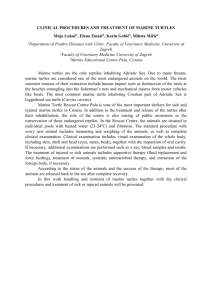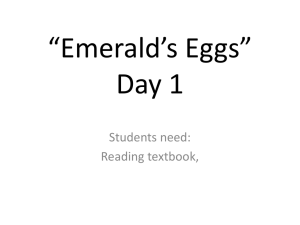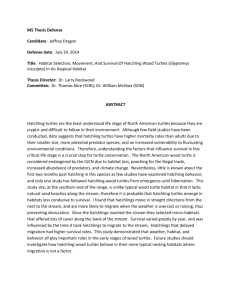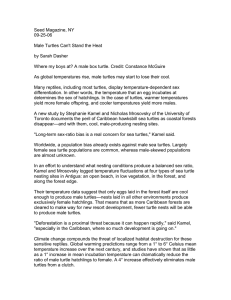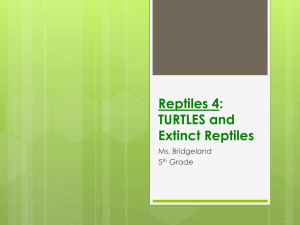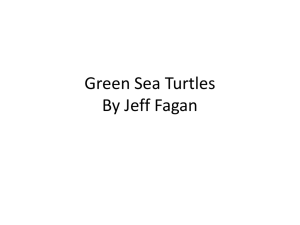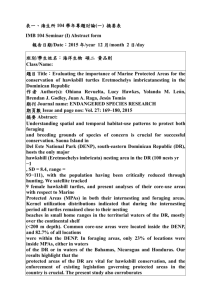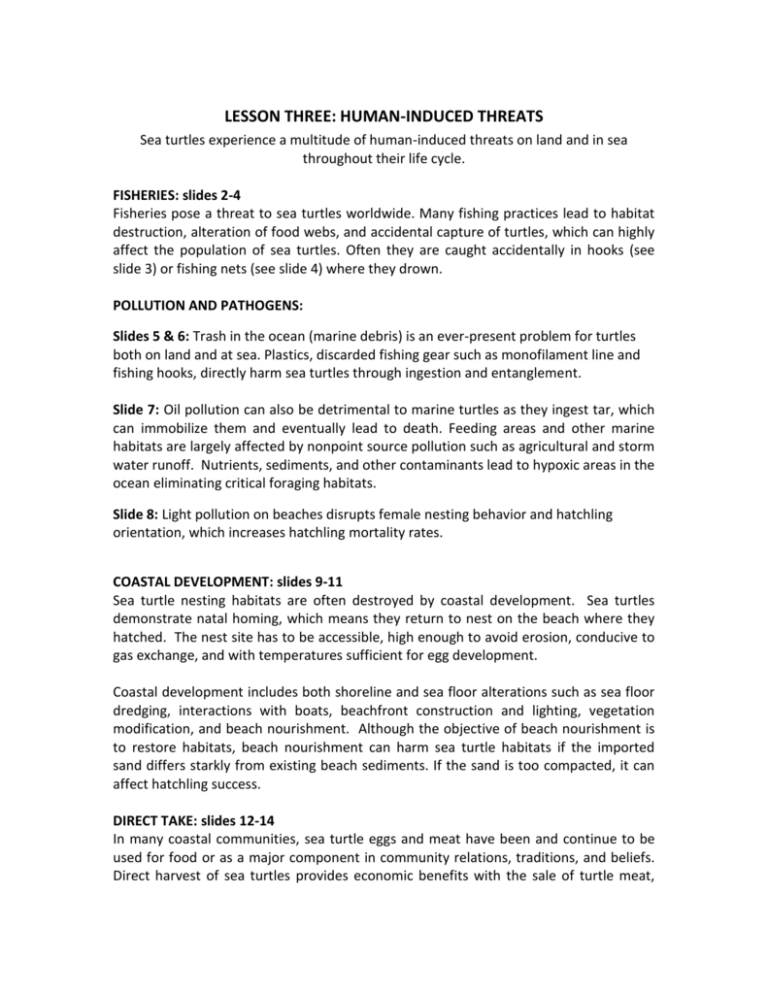
LESSON THREE: HUMAN-INDUCED THREATS
Sea turtles experience a multitude of human-induced threats on land and in sea
throughout their life cycle.
FISHERIES: slides 2-4
Fisheries pose a threat to sea turtles worldwide. Many fishing practices lead to habitat
destruction, alteration of food webs, and accidental capture of turtles, which can highly
affect the population of sea turtles. Often they are caught accidentally in hooks (see
slide 3) or fishing nets (see slide 4) where they drown.
POLLUTION AND PATHOGENS:
Slides 5 & 6: Trash in the ocean (marine debris) is an ever-present problem for turtles
both on land and at sea. Plastics, discarded fishing gear such as monofilament line and
fishing hooks, directly harm sea turtles through ingestion and entanglement.
Slide 7: Oil pollution can also be detrimental to marine turtles as they ingest tar, which
can immobilize them and eventually lead to death. Feeding areas and other marine
habitats are largely affected by nonpoint source pollution such as agricultural and storm
water runoff. Nutrients, sediments, and other contaminants lead to hypoxic areas in the
ocean eliminating critical foraging habitats.
Slide 8: Light pollution on beaches disrupts female nesting behavior and hatchling
orientation, which increases hatchling mortality rates.
COASTAL DEVELOPMENT: slides 9-11
Sea turtle nesting habitats are often destroyed by coastal development. Sea turtles
demonstrate natal homing, which means they return to nest on the beach where they
hatched. The nest site has to be accessible, high enough to avoid erosion, conducive to
gas exchange, and with temperatures sufficient for egg development.
Coastal development includes both shoreline and sea floor alterations such as sea floor
dredging, interactions with boats, beachfront construction and lighting, vegetation
modification, and beach nourishment. Although the objective of beach nourishment is
to restore habitats, beach nourishment can harm sea turtle habitats if the imported
sand differs starkly from existing beach sediments. If the sand is too compacted, it can
affect hatchling success.
DIRECT TAKE: slides 12-14
In many coastal communities, sea turtle eggs and meat have been and continue to be
used for food or as a major component in community relations, traditions, and beliefs.
Direct harvest of sea turtles provides economic benefits with the sale of turtle meat,
eggs, oil, leather, and their shell. In addition, turtle parts are used for medicinal
purposes and as an aphrodisiac.
For many human communities around the world, sea turtles are a source of income and
sustenance that are vital to survival. The challenge in mitigating the direct harvest of
turtles and their eggs is to draw communities into programs that encourage sea turtle
conservation by generating direct and indirect benefits of conservation.
CLIMATE CHANGE: slides 15-17
Climate change is of particular importance to sea turtles because it can affect adult
distribution and sex ratios of hatchlings through a change in land and sea temperature.
Sea turtles do not have sex chromosomes and exhibit temperature-dependent sex
determination (TSD). In other words, whether they are male or female is determined by
temperature in the nest.
Sea level rise, which leads to the loss of nesting beaches, is an imminent threat to sea
turtle habitats and survival. Other extreme weather events such as hurricanes, floods,
drastic seasonal changes and ocean acidification also affect terrestrial and marine
habitats for these species.
WHAT CAN YOU DO TO HELP?
Watch Video:
Find your moment link: http://www.youtube.com/watch?v=hZR214wjIfA
ACTIVITY (SEE CURRICULUM GUIDE)




